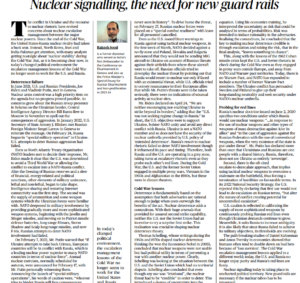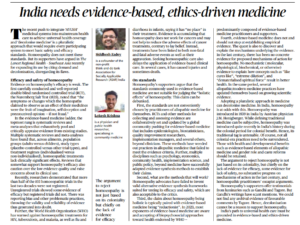Nuclear signalling, the need for new guard rails

Introduction:
- The conflict in Ukraine and the resurgence of nuclear rhetoric between the United States and Russia have raised alarm bells about nuclear escalation management.
- While during the Cold War, the focus was primarily on nuclear rivalry between the U.S. and Russia, attention shifted to other nuclear powers like North Korea, Iran, and India-Pakistan after the Cold War.
- However, the current political landscape has rendered the Cold War’s escalation management lessons inadequate for dealing with the tensions between the U.S. and Russia.
Deterrence Failure:
- Despite high-priority talks on nuclear arms control between U.S. President Joe Biden and Russian President Vladimir Putin, no progress was made.
- As tensions grew over the Russian troop presence in Belarus near the Ukrainian border, U.S. attempts to deter Russian aggression proved unsuccessful.
- NATO got involved in the conflict, supplying military assistance and advanced weapons to Ukraine despite Russian threats.
- Russia’s attempts to deter NATO involvement through nuclear rhetoric also fell short, and both sides found themselves in a grey zone, engaging in escalatory rhetoric while probing each other’s red lines.
Cold War Lessons:
- During the Cold War, both the U.S. and the Soviet Union engaged in proxy wars in distant regions like Vietnam and Afghanistan.
- The key to nuclear deterrence was the understanding that both sides possessed large arsenals with assured second-strike capability, making a surprise first strike unattractive.
- This realization shaped nuclear deterrence theory, emphasizing the credibility of the nuclear threat to prevent war with another nuclear power.
- Risk and uncertainty were introduced to induce rationality in adversaries and keep rhetoric in check.
Probing for Red Lines:
- Russia’s nuclear doctrine outlines two conditions for using nuclear weapons: in response to nuclear or other types of weapons of mass destruction against Russia or its allies and in the case of aggression with conventional weapons threatening the existence of the state.
- Russia views Ukraine as not entirely sovereign due to historical and cultural ties.
- It has also considered using tactical nuclear weapons to break a battlefield stalemate, but the U.S. has rejected this strategy due to the potential for uncontrolled escalation.
New Guard Rails for Nuclear Signaling:
- The current geopolitical landscape is vastly different from the Cold War era, with NATO expanding and former Warsaw Pact members seeking security under the nuclear umbrella.
- The old escalation management lessons may no longer apply as the U.S. and Russia no longer enjoy parity, and Russia’s red lines are unclear.
- Nuclear signaling is occurring in uncharted territory, necessitating new guard rails to preserve the nuclear taboo and prevent accidental escalation.
Conclusion:
- The conflict in Ukraine has highlighted the need to reevaluate nuclear escalation management between major powers. The traditional Cold War lessons no longer provide a comprehensive framework to deal with the complexities of today’s political environment.
- Both the U.S. and Russia are navigating a delicate balance of rhetoric and probing for red lines. Preserving the nuclear taboo requires new approaches and clear communication to avoid unintended nuclear escalation.
Source: The Hindu
India needs evidence-based, ethics-driven medicine

Introduction:
- The push to integrate ‘AYUSH’ (Ayurveda, Yoga, Unani, Siddha, and Homoeopathy) medicinal systems into mainstream healthcare to achieve universal health coverage and decolonise medicine is gaining momentum.
- However, this pluralistic approach demands that each participating system meets basic safety and efficacy standards.
- Homoeopathy, though a part of AYUSH, falls short of meeting these standards.
- Despite its flaws and weak evidence on efficacy and safety, some supporters advocate for its expansion, citing demand and decolonisation.
Efficacy and Safety of Homoeopathy:
- The evidence on homoeopathy’s efficacy is weak, with early studies discrediting its claimed effects.
- Numerous systematic reviews and meta-analyses have consistently shown that homoeopathic treatments lack clinically significant effects across various ailments, age groups, study types, and treatment regimes.
- Even reviews somewhat supporting homoeopathy’s efficacy raise concerns about the low quality of evidence and its clinical applicability.
- Recent research has revealed that more than half of the homoeopathic trials conducted in the last two decades were not registered. Unregistered trials showed some evidence of efficacy, but registered trials did not, casting doubt on the validity and reliability of evidence generated.
- Furthermore, the World Health Organization (WHO) has warned against homoeopathic treatments for serious conditions like HIV, tuberculosis, malaria, flu, and infant diarrhea, stating that it has “no place” in their treatment.
- Homoeopathy has also been associated with adverse events and may cause delays in receiving evidence-based clinical care, resulting in injuries and sometimes death.
Standards and Holistic Claims:
- Homoeopathy’s supporters argue that conventional evidence-based medicine standards are not suitable for judging its “holistic effects.”
- However, these standards are not arbitrarily chosen by allopathic practitioners; they are established collaboratively by a global community, including epidemiologists, biostatisticians, and others.
- Various disciplines beyond medicine have successfully adapted evidence synthesis methods.
- The claim that evidence-based medicine is “reductionist” is countered by its acceptance and endorsement of biopsychosocial approaches toward health.
- Homoeopathy advocates have failed to propose valid alternative evidence synthesis frameworks for testing efficacy and safety that are acceptable to critics.
- Additionally, there is no concrete evidence for proposed mechanisms of action for homoeopathy, whereas modern medicine practices have updated based on growing scientific evidence.
Decolonisation and Homoeopathy:
- While adopting a pluralistic approach can decolonise medicine, homoeopathy’s introduction in India during the colonial period for colonial benefit challenges its traditional tag.
- Supporting homoeopathy based on decolonisation is weak, considering the lack of evidence for its efficacy, some evidence against safety, and the absence of substantive progress on its mechanisms of action.
- Testimonials from luminaries like Gandhi and Tagore lack solid archival evidence, further weakening the decolonisation argument.
Conclusion:
To achieve universal health coverage in India, an evidence-based and ethics-driven approach to medicine is crucial.
While the integration of AYUSH systems into mainstream healthcare can be beneficial, homoeopathy’s efficacy and safety concerns raise doubts about its suitability.
Placing evidence and ethics at the forefront of medical decision-making is essential for the successful implementation of a pluralistic approach that truly advances healthcare for all.
Source: The Hindu

